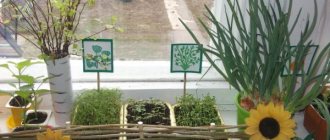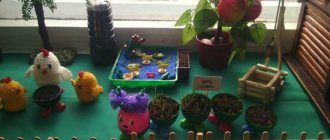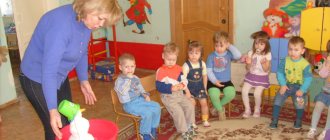Educational and research project “Miracle garden on the windowsill” in the junior group of kindergarten
Objective of the project:
nurturing the ecological culture of children, developing interest in cognitive and research activities, instilling in children a love of nature, creating a vegetable garden on the windowsill in the group, as well as developing the aesthetic feelings of preschoolers.
Project objectives:
1. Expand children’s knowledge about cultivated plants, their structure and plant growth conditions;
2. To generate interest in cognitive and research activities;
3. Give children a primary idea of certain living conditions of plants and organisms (soil, moisture, temperature, sun, light);
4. Continue to acquaint children with the features of growing cultivated plants - onions, dill, wheat;
5. Develop children's creative abilities, a sense of responsibility for the growth and development of plants;
6. Develop children’s coherent speech, activate children’s vocabulary according to this project;
7. Foster respect for work, careful and caring attitude towards plants.
Expected results:
With the help of a vegetable garden on the window, we will not only tell you, but also show you how you can grow a plant from a seed, bulb, or grain that will grow, then bloom and bear fruit. Children will develop an interest in plants. They will be able to distinguish between certain types of plants (tomato, pepper, onion, cucumber, etc.). Learn and consolidate knowledge about the structure of a plant. They will learn a lot of interesting things about plant life. The children will learn to make observations and draw the first conclusions in their lives.
Project implementation plan:
Preparatory:
Studying methodological literature and collecting information material to create the “Miracle of the Vegetable Garden on the Window.” Drawing up an action plan for organizing children's activities. Creating conditions for the project.
Basic:
carrying out planned activities for the implementation of the project (conversations, experiments, observations, experiments, creative activities, reading, looking at illustrations).
Final:
Analyze and summarize the results obtained in the process of research activities. Children's book competition "Riddles about vegetables". Dramatization of the fairy tale "Turnip". Processing and design of materials in the form of a presentation.
Stages of work on the project:
1. Preparatory:
• Defining the goals and objectives of the project.
• Studying methodological literature on the topic.
• Drawing up a work plan for the project “Miracle - vegetable garden on the window.”
• A selection of games, conversations, visuals, fiction and scientific literature, material for various activities, purchasing the necessary equipment and seeds.
• Creation of conditions for the project.
• Conversation with parents “Vegetable garden on the window.” Discuss the goals and objectives of the project. Generate among parents an interest in creating conditions for the implementation of the project.
Project “Vegetable Garden on the Window”
Yulia Alekseevna Motornaya
Project “Vegetable Garden on the Window”
Material for the competition “Vernissage of Ideas”
teachers of the Khvalynsky district.
Nomination: Vernissage of ideas on the topic: “Miracle garden ”
in Group"
Full name - Yulia Alekseevna Motornaya
Position: educator.
Work experience - 6 years.
Content
1. Relevance of the chosen topic ___ page 3
2. Description of the work to create a subject-development environment___page. 5
3. Organization of children's activities___p. 6
4. Summary of children's activities___p. 7
Conclusion___page 8
1. Relevance of the chosen topic.
Introducing a child into the world of nature, forming realistic ideas - knowledge about its objects and phenomena, cultivating the ability to see the beauty of native nature, love, a careful and caring attitude towards it - are the most important tasks of a preschool institution.
Communication with nature has a positive effect on preschool children, makes them kinder, softer, and awakens the best feelings.
Indoor plants not only provide an opportunity to organize interesting and meaningful educational work with children, they improve the microclimate of the room in which children are: they humidify the air, purify and enrich it with oxygen.
The relevance of this topic is to clarify and consolidate children’s ideas about vegetables that differ from each other in appearance and method of growth, to systematize knowledge about the planting process, to teach them to accept a goal, to determine the subject of work, to select tools and materials for work, to determine the sequence of work actions.
Target:
creating conditions in the group for the development of cognitive interest in research activities, revealing the creative and intellectual potential of preschool children, involving children in practical activities of growing cultivated garden plants .
Tasks:
1. Teach children to care for garden plants .
2. Give children a visual representation of the needs of plants for light, heat, moisture, and soil for plant growth.
3. Develop children's cognitive and creative abilities.
4. Create conditions for parental participation in the educational process.
5. Consciously form the correct attitude towards the nature of the native land, towards human work.
2. Description of the work to create a subject-development environment.
“Subject-Developing Environment”
is a system of material objects and means of a child’s activity that functionally models the content of the development of his spiritual and physical appearance in accordance with the requirements of the basic general educational program of preschool education.
A developmental environment is needed, firstly, in order to raise a successful, independent, proactive, creative child.
In the nature corner we stimulate and support children’s cognitive interest in natural objects; we develop labor skills in caring for living objects; We cultivate a caring attitude towards nature.
Of course, we are helped with this by:
— didactic games aimed at the formation and development of ecological knowledge of the surrounding world;
— models of plant structure, signs of living things, phenological changes in nature;
— albums, photographs, illustrations, paintings;
— weather and nature calendars;
— a selection of poems, proverbs, sayings, signs, riddles about vegetable crops;
- children's drawings and crafts made from natural materials;
— equipment for planting seeds and seedlings;
— «vegetable garden on the window»
The entire group space is available to children: toys, teaching material, games. They know very well where to get equipment for caring for plants, paper, paints, pencils, natural materials, costumes and attributes for stage games.
3. Organization of children's activities.
In March, my children and I worked like bees - doing spring planting: preparing the soil, planting bulbs, oats, tomatoes, cucumbers, dill, watering, loosening, eagerly waiting and watching for the first sprout to appear.
We took care of the plantings with pleasure, and it couldn’t have been any other way! After all, on the windowsill, next to the onion bed, small, smiling “Men”
with mischievous button eyes and a hedgehog whose green needles grow by leaps and bounds.
The changes taking place here are fast, bright, and visual. They put a seed in the ground, said the magic words - and lo and behold, after a few days, sprouts made their way to the light. Day after day they gain strength and grow, delighting children with their greenery. The children are very proud of the results of their work. This is the most beloved, “magical”
place for guys.
In the process of such activities, children consolidate and expand their knowledge about vegetable crops and their use, they master the skills of caring for plants, and begin to understand what an important role conditions play in the life of plants and how people can influence them.
While caring for plants, children observe the growth of plants from seed to seed. They sketch all their observations, creating mini-books, and then tell other children how they grew the plants, what conditions influenced its growth. The children, together with adults, come up with recipes for vegetable dishes.
There is still snow outside the window, but spring is already reigning in the group and pleases with the first greenery. Soon the guys will harvest their first harvest. What could be tastier and healthier than greens grown by yourself!
4. Summary of children's activities.
We gradually collected a collection of seeds. Algorithms for plant care were developed. We made a selection of educational games, poems and riddles about vegetables. We created an album with illustrations of vegetable crops. We made masks of vegetables and fruits to act out fairy tales.
The following experiments were carried out:
— observations of the growth of the onion root system in water;
- germination of pea and oat seeds in cotton wool between transparent planes.
Children watched the growth of plants and kept a diary where they made sketches. We also constructed a basket for vegetables and fruits out of paper, and played educational games “Botanical Lotto”
,
“Find a vegetable by description”
,
“What grows in
the garden ” ,
“Wonderful bag” (vegetables and fruits)
.
“Guess by taste”
, we conducted a role-playing game
“Vegetable shop”
.
They guessed “Riddles in the garden.”
We had conversations on the topic:
“What kind of crop has grown
,
“What is growing in your
garden .” We composed a descriptive story on the topic:
“How we grew vegetables
.
And, of course, we read fiction: N. Nadezhdin’s “Where the cabbage soup is, look for us there!”
, Y. Taits
“Obedient Rain”
, Y. Tuvim
“Vegetables”
, V. Suteeva
“Apple”
.
Russian folk tale “Tops and Roots”
, Belarusian fairy tale
“Puff”
, Ukrainian fairy tale
“Spikelet”
. They painted a still life with vegetables, sculpted vegetables and fruits.
They worked caring for plants in a corner of nature.
Conclusion
The children enjoyed tasting the greens they had grown with their own hands. An exhibition of children's works was organized. But our concern for vegetable crops did not end there; we will plant our seedlings in the garden and look forward to the harvest.
The vegetable garden on the window has become a good help and assistant in instilling an ecological culture in children, creating the right attitude towards living nature. He is able to expand children’s ideas about plants as living organisms, about the conditions necessary for growth and development, develop an ethical sense, the ability to enjoy the beauty of the plants grown and the result of their work.
Do I need to talk about how nice it is to serve in winter (spring)
to the table dishes decorated with green sprigs of parsley and dill. And beautiful and tasty, and good for the health of our children. And most importantly, it is accessible to everyone, and children raised it.
GREENS FOR CHILDREN
But, in most cases, kids don’t like greens in their pure form. Most likely, this is due to its rich taste. Or the child gives preference to one type, categorically rejecting others. In such a situation, there is no need to insist. You can add a very small amount of chopped greens to first or second courses, or to salads. Over time, the child will get used to this supplement. After all, not all vegetables, fruits and berries are to your liking the first time. Sometimes it takes time to try a particular product.
When can you give greens to your child? Greens can appear in children's diets from the eighth month. But to do this, it should be thoroughly crushed using a blender. And then add small amounts to various dishes. After a year, it will be enough to finely chop the green leaves or onion feathers with a knife. And after one and a half years, the baby can be offered various vegetable salads with the addition of herbs. A tasty salad made from various types of greens, to which hard-boiled and finely chopped eggs is added. This dish should be seasoned with vegetable oil and lightly salted.
Any greenery grows on the ground, so in order to avoid the appearance of such an unpleasant problem as Worms in a child, special attention should be paid to washing it. It is not enough to simply rinse a green bunch under running water. First, place it in a container of water and let it stand for a few minutes. This way the soil particles will become wet and will be easier to wash off. Then rinse the leaves several times in a new portion of water. After this, rinse them in running water and place them on a clean, dry towel. After the water has drained, you can start cooking.
Practical lesson “Vegetable garden on the windowsill”
Tasks. Activate children's understanding of the appearance of seeds: tomato, cucumber, dill, planting skills. Clarify children's understanding that a plant grows from seeds. To develop the ability to plant seeds correctly by making a hole. Develop speech, enrich vocabulary, ability to listen carefully, and answer questions posed.
Materials and equipment. Watering cans with water, containers with soil, seeds (tomato, cucumber, beets), plates, Fedora doll.
Progress of the lesson.
Educator. Guys, look how many different things I prepared for you, oh, what is this box, it wasn’t here. (Tears off the box, lies the bell, rings it.)
Fedora appears.
Educator. Guys, who came to us? This is Fedor's grandmother. Why are you so sad, what happened.
Fedora. Every spring I plant a lot of different vegetables, but this time I’m afraid I won’t succeed. My cat Murka was playing and mixed all the seeds for me. But my eyes don’t see well, and now I can’t tell where the seeds are. Help me please, guys.
Educator. Let's help Fedora. The guys and I were just looking at different seeds, and today we wanted to plant a vegetable garden on the windowsill, give us your seeds here. Guys, first we will sort out the seeds and then plant them. Name what seeds are here. (Children call the seeds of beans, peas, onions.)
Educator. Guys, I suggest you put the seeds on plates. You have plates of different colors. Matvey, Vika, Artem, what color plate do you want to collect the seeds in? (green) Amina, Lyuda, Vova, and you? (blue). (Children complete the task.)
Educator. Well done, guys, you laid out the seeds correctly. And today I want to introduce you to other seeds, but first guess the riddles.
I'm important and juicy
My cheeks are red. (Tomato.)
There is grass above the ground,
Burgundy head underground. (Beet.)
No windows, no doors
The room is full of people. (Cucumber.)
Educator. Look at these tomato seeds. What are they? (rough, round, shaggy). And these are cucumber seeds. What are they? (oval, yellow, hard). And here are the beet seeds. What are they? (brown, round, prickly).
Look how interesting it is that a beautiful and juicy fruit grows from such a small seed (the teacher shows a diagram of plant growth).
And now you and I will plant our seeds. What needs to be done for this? (First you need to make a hole and put one seed there, then sprinkle it with earth and water it from a watering can.)
Educator. But we will plant beets by making a furrow and sowing seeds. (The teacher shows how to do this.) How many of you know what needs to be done to make the seeds germinate faster? (Cover with film, place in a warm place, there should be light.)
The children plant a vegetable garden with the help of the teacher and Fedora.
Fedora. Well, guys, what a great fellow you are. They helped me sort the seeds, and I learned how to germinate the seeds even faster. And now it's time for me to go home. (He says goodbye and leaves.)
Q. Well, guys, did you like our lesson? We will watch how our plants grow.







